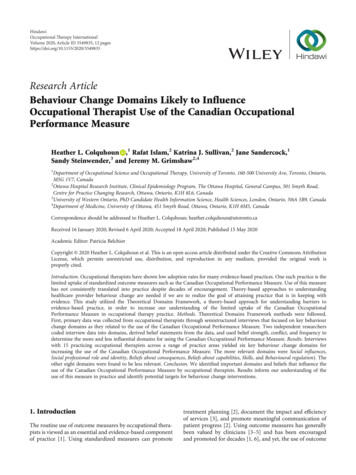
Transcription
HindawiOccupational erapy InternationalVolume 2020, Article ID 3549835, 12 pageshttps://doi.org/10.1155/2020/3549835Research ArticleBehaviour Change Domains Likely to InfluenceOccupational Therapist Use of the Canadian OccupationalPerformance MeasureHeather L. Colquhoun ,1 Rafat Islam,2 Katrina J. Sullivan,2 Jane Sandercock,1Sandy Steinwender,3 and Jeremy M. Grimshaw2,41Department of Occupational Science and Occupational Therapy, University of Toronto, 160-500 University Ave, Toronto, Ontario,M5G 1V7, Canada2Ottawa Hospital Research Institute, Clinical Epidemiology Program, The Ottawa Hospital, General Campus, 501 Smyth Road,Centre for Practice Changing Research, Ottawa, Ontario, K1H 8L6, Canada3University of Western Ontario, PhD Candidate Health Information Science, Health Sciences, London, Ontario, N6A 5B9, Canada4Department of Medicine, University of Ottawa, 451 Smyth Road, Ottawa, Ontario, K1H 8M5, CanadaCorrespondence should be addressed to Heather L. Colquhoun; heather.colquhoun@utoronto.caReceived 16 January 2020; Revised 6 April 2020; Accepted 18 April 2020; Published 15 May 2020Academic Editor: Patricia BelchiorCopyright 2020 Heather L. Colquhoun et al. This is an open access article distributed under the Creative Commons AttributionLicense, which permits unrestricted use, distribution, and reproduction in any medium, provided the original work isproperly cited.Introduction. Occupational therapists have shown low adoption rates for many evidence-based practices. One such practice is thelimited uptake of standardized outcome measures such as the Canadian Occupational Performance Measure. Use of this measurehas not consistently translated into practice despite decades of encouragement. Theory-based approaches to understandinghealthcare provider behaviour change are needed if we are to realize the goal of attaining practice that is in keeping withevidence. This study utilized the Theoretical Domains Framework, a theory-based approach for understanding barriers toevidence-based practice, in order to increase our understanding of the limited uptake of the Canadian OccupationalPerformance Measure in occupational therapy practice. Methods. Theoretical Domains Framework methods were followed.First, primary data was collected from occupational therapists through semistructured interviews that focused on key behaviourchange domains as they related to the use of the Canadian Occupational Performance Measure. Two independent researcherscoded interview data into domains, derived belief statements from the data, and used belief strength, conflict, and frequency todetermine the more and less influential domains for using the Canadian Occupational Performance Measure. Results. Interviewswith 15 practicing occupational therapists across a range of practice areas yielded six key behaviour change domains forincreasing the use of the Canadian Occupational Performance Measure. The more relevant domains were Social influences,Social professional role and identity, Beliefs about consequences, Beliefs about capabilities, Skills, and Behavioural regulation). Theother eight domains were found to be less relevant. Conclusion. We identified important domains and beliefs that influence theuse of the Canadian Occupational Performance Measure by occupational therapists. Results inform our understanding of theuse of this measure in practice and identify potential targets for behaviour change interventions.1. IntroductionThe routine use of outcome measures by occupational therapists is viewed as an essential and evidence-based componentof practice [1]. Using standardized measures can promotetreatment planning [2], document the impact and efficiencyof services [3], and promote meaningful communication ofpatient progress [2]. Using outcome measures has generallybeen valued by clinicians [3–5] and has been encouragedand promoted for decades [1, 6], and yet, the use of outcome
2measures as a routine aspect of occupational therapy practiceremains limited [7–10].Accurate expectations for outcome measure use rates inoccupational therapy remain challenging as research in thisarea has been limited, and use rates are typically based on aself-report survey [9–11]. Of these self-report surveys, studiesindicate that use ranges from as low as 1% [12] to as high as10% [11]. Studies on use rates presenting hypothetical clientcases have found higher rates of up to 44% [10]. Actual userates, as evidenced by chart review or observation, to ourknowledge have not been published.Similar trends of use are found for the Canadian Occupational Performance Measure (COPM) [13]. The COPM is asemistandardized and gold standard occupational therapyinstrument designed to determine relevant occupational performance issues and measure client perceptions of change inperformance and satisfaction with those issues over time[13]. Despite its relevance to occupational therapy, andapproximately 30 years of encouragement to therapists toadopt the measure including knowledge translation effortsto support COPM use such as e-learning modules (http://www.thecopm.ca/learning-module/), use rates specific tothe COPM are surprisingly low [12]. When prompted in asurvey for desired assessment of participation post stroke,2-4% of occupational therapists suggested the COPM [14].In the delivery of occupational therapy for cerebral palsy, ahigher rate of 26% intended use of the COPM was found,although this was based on self-report [10]. Evidence insupport of verified COPM use rates in routine clinical practice is limited.A systematic review to examine the barriers and facilitators to outcome measure use by allied health professionals(i.e., occupational therapy, physiotherapy, and speechlanguage pathology) found 15 studies [3]. Key barriersincluded knowledge and confidence with using outcomemeasures, time limitations, and the degree of peer andorganizational support for using measures. To date, studiesindicate that alleviating these barriers does not result insustained and routine use of standardized outcome measures [4, 15]. In addition, there remain discrepant viewsand attitudes towards outcome measurement by therapists.Colquhoun (2010) interviewed occupational therapistsafter they had been required to administer the COPMfor 5 months. The therapists perceived and indeed experienced many benefits from using the COPM (e.g., caremore focused on occupation and more client centredness)and recommended the routine use of the COPM. Yet,overall, the occupational therapists did not plan to continue using the COPM after study completion. Other surveys have found the same favourable attitudes to outcomemeasure use but with a lack of reported use rates in thesame sample [5]. In a survey study examining occupational therapist attitudes and measurement use rates, therespondents cited lack of time as a barrier to standardizedoutcome measure use; yet, at the same time, 90% of therespondents reported the use of nonstandardized measures[11]. Efforts to better understand these barriers are neededto guide the development of interventions designed toimprove adoption rates.Occupational Therapy InternationalOur understanding of why the COPM has seen such limited uptake in occupational therapy practice remains limited,particularly with respect to beliefs and attitudes that could beamenable to change. One approach to barrier identificationthat targets these issues is the Theoretical Domains Framework (TDF) [16, 17]. The TDF is a broad-based theoreticalframework that condenses 128 constructs from 33 key behaviour change theories into a set of 14 domains of behaviourchange. The framework assists in the identification of whichdomains, and the associated modifiable beliefs, appear mostcrucial for changing a behaviour. The objective of this studywas to use the TDF to improve our understanding of whatbeliefs influence the use of the COPM by occupationaltherapists.2. MethodsWe conducted a TDF study [17]. The overall approachincludes mapping interview utterances to the TDF domains,developing belief statements consistent with utterances, andanalyzing belief statements for their relevancy to changingthe target behaviour (i.e., increasing the use of the COPMby occupational therapists). Ethics approval was obtainedfrom the Ottawa Health Science Network Research EthicsBoard, Ottawa, Canada (#20130367-01H).2.1. Participants. Using purposive sampling, we recruitedoccupational therapists across all services in the occupationaltherapy department of a large urban health network inOntario, Canada, that included several sites and therapistsin various departments practicing in acute care, inpatient,and outpatient occupational therapy. All therapists were eligible who carried out any amount of clinical caseload andworked in any clinical area. Consistent with TDF studies,we aimed to interview approximately 12 therapists whosepractice context would support using the COPM.2.2. Data Collection and Procedures. The TDF interviewguide was developed and pilot tested to elicit an understanding of participant beliefs related to the 14 domains in the2012 version of the TDF [17]. The 14 domains are as follows:Knowledge, Skills, Social professional role and identity, Beliefsabout capabilities, Optimism, Beliefs about consequences,Reinforcement, Intentions, Goals, Memory/Attention decisionprocesses, Environmental context and resources, Social influences, Emotion, and Behavioural regulation (see Table 1 fora summary of domain definitions). In order to design theguide, we drew upon the expertise of our team in conductingTDF interviews (HLC, RI, and JMG) as well as publicationsof TDF studies that included interview guides that targetedhealth care provider behaviour change [18]. Example questions included the following: to understand Beliefs about consequences, we asked, “What do you think will happen if youuse the COPM with your inpatients, both positive and negative?”; and to understand Social influences, we asked, “Wouldany other team members influence whether or not you usethe COPM with your inpatients?” and “How does the patientaffect your decision to use the COPM?” We did not ask participants if they used the COPM as we were aware that the
Occupational Therapy International3Table 1: TDF domains and their definitions [17].TDF domainKnowledgeSkillsSocial professional role and identityBeliefs about capabilitiesOptimismBeliefs about ention decision processesEnvironmental context and resourcesSocial influencesEmotionBehavioural regulationDefinitionAn awareness of the existence of somethingAn ability or proficiency acquired through practiceA coherent set of behaviours and displayed personal qualities of an individual in a social orwork settingAcceptance of the truth, reality, or validity about an ability, talent, or facility that a person canput to constructive useThe confidence that things will happen for the best or that desired goals will be attainedAcceptance of the truth, reality, or validity about outcomes of a behaviour in a given situationIncreasing the probability of a response by arranging a dependent relationship, orcontingency, between the response and a given stimulusA conscious decision to perform a behaviour or a resolve to act in a certain wayMental representations of outcomes or end states that an individual wants to achieveThe ability to retain information, focus selectively on aspects of the environment, and choosebetween two or more alternativesAny circumstance of a person’s situation or environment that discourages or encourages thedevelopment of skills and abilities, independence, social competence, and adaptive behaviourThe interpersonal processes that can cause people to change their thoughts, feelings,or behavioursA complex reaction pattern, involving experiential, behavioural, and physiological elements,by which the individual attempts to deal with a personally significant matter or eventAnything aimed at managing or changing objectively observed or measured actionsNote. TDF: Theoretical Domains Framework.COPM was being used minimally in the study environmentand we believed that if we directed their attention to low compliance this could increase self-presentation bias and lead toparticipants erroneously focusing on external factors [19](see Supplemental file 1 for a copy of the interview guide).Potential participants received information regarding thestudy during a staff meeting and were asked to contact theresearch team if they were interested in being interviewed.All participants provided informed consent. The interviewswere face-to-face and lasted approximately 30-45 minutes.2.3. Data Analysis. Our approach to analysis including theframework for the coding process followed several publishedTDF studies that were part of a special TDF thematic series inImplementation Science and attempted to understand healthcare delivery practices from the viewpoint of healthcare providers [18, 20]. The first step was to transcribe the interviews.Next, using NVIVO, two researchers independently codedutterances from the interviews into TDF domains (e.g., Socialinfluences and Beliefs about capabilities). The two first transcripts were used to establish an understanding between thetwo coders as to how the utterances in the interviews shouldbe coded into the 14 TDF domains. This coding occurred intandem. Discrepancies were discussed until both coders weresatisfied that a mutual understanding existed for the coding.Coding occurred independently for all transcripts from thatpoint on. The final coding was completed by comparing allcodes and using discussion to come to consensus on differences. All coding was done independently by two of HLC,RI, SS, and JS.The next step involved transferring the coded utterances,organized by domain, from NVIVO into Excel and developing a corresponding belief statement for each utterance codedinto a domain. The belief statements provide detail about theperceived role of the domain in influencing the behaviour. Ifmultiple utterances result in similar belief statements, patterns of consistencies and differences will emerge related tothe belief statements. As an example, utterances such as“Using the COPM takes practice,” “I think using the COPMis more about practice than experience,” and “The more youuse the COPM, the more information you get from it” couldall be grouped under the belief statement “Using the COPMtakes practice.” As another example, utterances such as “Normally I meet the patient and then decide if it’s an appropriatetool” and “Using the COPM will depend on the nature of theclient” could be grouped under the belief statement “My useof the COPM is influenced by my client.” Determining thebelief statements was achieved by two coders independentlydeveloping the statements, followed by consensus discussions to agree on final belief statements that both codersagreed were indicative of the utterance. Once consensus onall belief statements was achieved, belief statements in eachdomain were grouped into similar beliefs. The final list ofthe most relevant domains and beliefs (i.e., the factors mostlikely to influence the behaviour of using the COPM) wasdecided based on consensus of two coders and was conducted in keeping with recommended TDF analyses. Thisincluded having coders iteratively discuss the groupings ofbelief statements as well as the following three criteria: (1)frequency of the beliefs across interviews (i.e., how manybelief statements per domain), (2) presence of conflicting
4Occupational Therapy InternationalTable 2: Total number of beliefs per domain.DomainSocial influenceKnowledgeBeliefs about consequencesSocial professional role and identityEnvironmental context and resourcesMemory, attention, decision processesSkillsBeliefs about capabilitiesBehavioural ismTotalTotal number of beliefs13411611210196413937323028272411828Note. Italics indicate a relevant domain.beliefs (i.e., different belief statements within a domain thatindicated opposing beliefs), and (3) perceived strength ofthe beliefs impacting the behaviour (i.e., coder perceptionson how strong the specific beliefs appeared to be includingthe language used by participants such as “important” or“never” or “always”). Note that while each of the three criteria is relevant, each is considered in the context of the othertwo (e.g., while frequency is important, it does automaticallyindicate most relevant).3. ResultsFifteen occupational therapists were recruited across the participating health network. Therapists worked predominantlyin inpatient capacities (13/15 or 87%) with the remaining twoworking with outpatients. Of the therapists working withinpatients, four of these worked in inpatient psychiatry(4/13 or 31%) and nine (9/13 or 69%) provided longer termrehabilitation. Participants were all female and predominantly experienced therapists, having worked an average of19.2 years (minimum of 10 years and maximum of 27 years)as an occupational therapist. About a half of the therapistshad been working more than 21 years as occupational therapists (8/15 or 53%).Our study identified six domains that were most relevantto the use of the COPM (Social influences, Social professionalrole and identity, Beliefs about consequences, Beliefs aboutcapabilities, Skills, and Behavioural regulation). The remaining eight domains were deemed as less relevant (Knowledge,Environmental context and resources, Intention, Goals,Emotion, Reinforcement, Optimism, and Memory/Attentiondecision processes) (see Table 2 for a summary of all domainsand number of beliefs). In total, 828 beliefs were generated(see Table 3 for sample belief statements and sample quotesfor the relevant domains). Below is a summary of thedomains as well as the associated key beliefs with an emphasis on the more relevant domains.3.1. Most Relevant TDF Domains (N 6) and Key Beliefs.Social influences had the highest number of beliefs (n 134),and the perceived strength of the effect of the beliefs onthe behaviour was high. Social influences appeared to playa large role in determining whether the occupational therapists we interviewed chose to use the COPM. While the setting (e.g., level of acuity of patient and length of stay) andteam dynamics (e.g., interest or support of other team members, specifically physicians) were mentioned as influences tousing the COPM, the strongest social influence of whetherthe COPM was used appeared to be from the clients andnot from other team members. Therapists seemed to makea decision to use or not use the COPM based on client characteristics or perceptions of how clients would respond tothe measure. Therapists indicated various client characteristics that positively influenced COPM use such as using theCOPM with clients who they knew have ongoing issues theywanted to improve and clients who were higher functioningand the value of the COPM for clients who were strugglingwith setting goals. Therapists also spoke about choosing tonot use the COPM with clients whom they thought wouldhave a negative reaction to the measure, whom they believedwould become angry or agitated by it, or whom they feltwere too low functioning or had inadequate insight toengage in the process. Therapists reported that the COPMhas the potential to negatively impact rapport and limit therapeutic relationships, limiting their use of the COPM.Social professional role and identity had a high frequencyof beliefs (n 101) and strength in the perceived role of thebeliefs on the behaviour. Beliefs in this theme highlightedthe individual nature of an occupational therapist approachto assessment. Specifically, these assessment practices areviewed as autonomous and individually determined. Therapists frequently expressed the desire to “get information”about a client in different ways that suited their ownapproach and philosophy, their setting demands, or theneeds of the client. Many indicated that if they chose to usethe COPM at all, it was in a modified way, based on theirown individual need for information. Therapists appearedlargely unaware of what their occupational therapy colleagues were doing in terms of assessment practices or outcome measure use. More than that, however, they describedthe issue of assessment in practice as fundamentally individual and that they would be reluctant to ever suggest howanother therapist should conduct their assessment or useoutcome measures. In the case of the COPM, there did notseem to be a sense that the profession would make a “group”decision to use the COPM or that they would choose to influence their colleagues to use the COPM. This is consistentwith what was found in Social influences: the influencesseemed to come from clients more so than other occupational therapists.Beliefs about consequences had a high number of beliefs(n 112), strength of beliefs in influencing the behaviour,and conflicting beliefs. Therapists indicated many positiveconsequences of using the COPM including the facilitation
Occupational Therapy International5Table 3: Summary of relevant TDF domains with sample belief statements and sample quotes.Relevant TDF domainsBelief statementsSocial influences(i) My use of the COPM is influenced by myclients.Social professional role andidentitySample quote(i) “Normally I meet the patient and then decide if[the COPM] is an appropriate tool.” (D)(ii) “[Using the COPM] really depends on the patientand what their, you know, how they present.” (D)(i) “Well again [using the COPM] depends on theirdiagnosis. If they had a chronic disability and therewas ongoing issues for them that they wanted towork towards improving I think that the [COPM]would be an appropriate tool.” (O)(ii) “If I’m having a hard time establishing goals withsomebody then I would go to [the COPM].” (D)(ii) Client characteristics can positively and(iii) “Well they need to have insight, they need to be ablenegatively influence my use of the COPM.to answer the questions independently . and wellthey have to be cognitive.” (P)(iv) “Well the client [affects my decision to use theCOPM]. I mean if the client is really profoundlyimpaired and I know that they have severecomprehension difficulties you know they may notbe a person that I want to use [the COPM] on.” (A)(i) “Well [I might use the COPM] except for that clientthat is very abrupt and it would take me too muchenergy to get his anger down because he gets angryeasily.” (C)(ii) “If [the client] starts to get the feeling [when usingthe COPM] that the outcome measure is moreimportant [to me] and not what they are saying andthey are reluctant to rate [the COPM] or they do notget it I can lose them.” (I)(iii) “[The clients] can be depressed or angry, they are(iii) Perceptions that the client will have difficultyin this spectrum so do you want to agitate the angerwith the COPM will negatively influencemore [using the COPM] oh yeah you cannot domy use.all those things so then you are like precipitatingmore depression, right.” (J)(iv) “There are patients that when you say well I’mgonna ask you to rate on a scale of 1-10 howimportant it is or how you feel about it they getangry because they say well what do you think, whata stupid question. I cannot move anything on myright side and I can barely talk and then the patientwould get angry so that did that stop me [using theCOPM].” (Q)(iv) Other team members do not influence my use (i) “Other team members do not influence my use of theof the COPM.COPM.” (A, B, E)(i) “I guess it’s up to your discretion [using theCOPM] ” (G)(i) As an OT, I can decide what type of(ii) “I think there is room for choice and for you tomeasurement tools to use.decide what type of tools you want to use to measurea specific item.” (G)(i) “And then there’s the [COPM] rating scale whichsometimes I’ll ask [the clients] to just leave.” (H)(ii) I can choose to modify the COPM as needed.(ii) “ to be honest I rarely do it exactly the way it [theCOPM] is supposed to be done.” (B)(i) “So yeah I do not know how I would encourage theother team measures to use it. It’s pretty hard I find(iii) I am uncomfortable telling my peers what toto just assume somebody’s gonna use it or I thinkuse as an assessment.everybody does their thing their own way so it’s notsomething I’d push.” (E)
6Occupational Therapy InternationalTable 3: Continued.Relevant TDF domainsBelief statementsSample quote(ii) “No, I do not know who uses [the COPM] in mydepartment. It’s not a discussion that I have withother people.” (A)(iii) “I did a study on the COPM, I have worked here fora long time. I have never presented, never beenasked about its use and never have I done anythingto assist the therapists who use the COPM eventhough my managers know of my experience andhow I use it.” (I)Beliefs about consequences(i) The COPM offers benefits to clients.(ii) The COPM offers no benefits to clients.(iii) The COPM takes too much time.(i) “I think it helps my clients to maybe understandwhat information is important to me. I think it givesthe client an opportunity to actually talk about thethings that they’d like to be able to do better or to beable to do; so it gets at their personal goals.” (A)(ii) “I’ll use the COPM midway sometimes to ask themwhere they are at now and then I show what theywere at the beginning and that encourages them.”(C)(iii) “I think there is the possibility that we could misssomething and miss something that is important tothem that maybe they do not have an opportunityor they do not feel like saying and then if you gothrough that [COPM] form maybe it would identifysomething.” (F)(iv) “I would say the costs [of the COPM] are worth itfor the benefits that are achieved through a certaingroup of clientele.” (J)(i) “If I was to look at my ABI clients over the last 4-5years and pull out every COPM I’ve done the ironyis I would find the same first 3 goals constantly, it iswell 90% of the case.” (E)(ii) “There’s lots of very, very skilled therapists that Iwork with who are excellent at their jobs and havenever touched the COPM.” (A)(iii) “I’m not convinced that I would gain a lot morethan what I’m actually doing right now [withoutthe COPM].” (B)(iv) “I do not use it [the COPM] with my currentclients and it’s fine too.” (E)(v) “ you end up with some goals [when using theCOPM], some of them are good, some of them youcannot really work on.” (F)(vi) “I do not feel that our patients are less, I do notthink if I do not use it [the COPM] I do not thinkthe clients are less what’s the word getting less of atreatment session.” (F)(vii) “Nothing bad happens if somebody does not [usethe COPM] because everybody is very skilled, verycompassionate, very knowledgeable, motivated.”(Q)(viii) “I know it sounds bad but like who will be lookingat the [COPM] like we have so many things to dolike it’s gonna not make a difference. I think if itwas making a difference we would do the effort.” (P)(i) “A negative aspect of using the COPM I thinkbecause of the time component with it then Iprobably would have to see less people.” (H)
Occupational Therapy International7Table 3: Continued.Relevant TDF domainsBeliefs about capabilitiesSkillsBelief statementsSample quote(iv) My clients will not like doing the COPM.(i) “On the other hand, I can also get the opposite theyget frustrated, angry, want to leave. I lose them in theinterview which just means that I’ve pushed a bithard and I’m pushing because I want the outcome. Iwant the numbers and they are not ready for it,cannot do it and if they refuse after 3 questionsthen I’ve got to stop and then I may not get thatopportunity again, right.” (I)(i) “I’m fairly confident about it.” (A)(ii) “I find it quite straightforward it’s easy to use.” (D)(iii) “I have used it with patients before so yes I amcomfortable with it.” (J)(iv) “Using the COPM is easy.” (Q)(i) “It’s not always easy to use.” (D)(ii) “Because it’s so very seldom that I use it I would notsay that it’s easy to use.” (B)(iii) “If you want it to be standardized to ask thequestion exactly how it’s said I was not able to doit.” (C)(iv) “It is more difficult because I even find that applyingit is kind of like a process.” (F)(iii) I am not confident and comfortable using theCOPM.(v) “So I think I have to educate myself a little bit more(iv) The COPM is difficult to use.just improve my skills to use the COPM and feelcomfortable with using the COPM.” (G)(vi) “ the hardest part about using the COPM isknowing the questions to ask. If you knew thequestions to ask you could probably be moreefficient using it.” (H)(vii) “I would have to practice a few times I have notused it in a long time.” (J)(i) I am confident and comfortable using theCOPM.(ii) The COPM is easy to use.(i) Few skills are needed to use the COPM.(ii) Many skills are needed to use the COPM.(i) “But you know the fact that students are able to do itsuggests to me that .you can use it [the COPM]without having a lot of prior experience.” (A)(ii) “Not a lot of experience is needed to use the COPM.”(P)(i) “Well I think your interviewing skills are obviouslyimportant. Your ability to keep the client on track isimportant. You know sometimes when you aretalking about their previous life, sometimes theystart crying and there’s this element of being ableto continue on with the [COPM] interview, nottrying to avoid it because you know that the client’suncomfortable with it.” (A)(ii) “I think you need some clinical judgement and youknow to be able to guide the patient on what mightbe realistic and not realistic depending on theiroverall condition.” (D)(iii) “I think you need to be fairly experienced in yourinterviewing in order to really just use the COPMin its form that it’s in now I think you’d probablyneed to have 2-3 years of experience.” (H)(iv) “ the patients do not get the concept ofoccupation. And so it’s very hard as an OT it’s not[just] using the COPM it’s going that one stepfurther beyond to talk about occupation.” (I)
8Occupational Therapy InternationalTable 3: Continued.Relevant TDF domainsBelief
Research Article Behaviour Change Domains Likely to Influence Occupational Therapist Use of the Canadian Occupational Performance Measure Heather L. Colquhoun ,1 Rafat Islam,2 Katrina J. Sullivan,2 Jane Sandercock,1 Sandy Steinwender,3 and Jeremy M. Grimshaw2,4 1Department of Occupational Science and Occupational Therapy, University of Toronto, 160-500 University Ave, Toronto, Ontario,

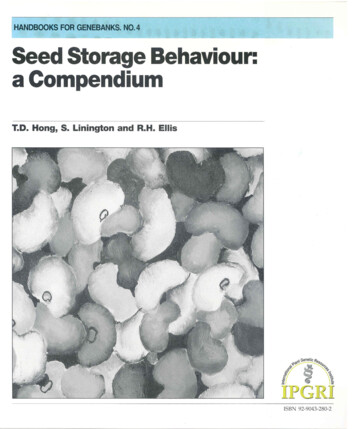
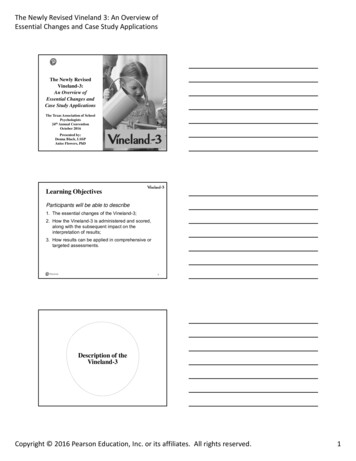

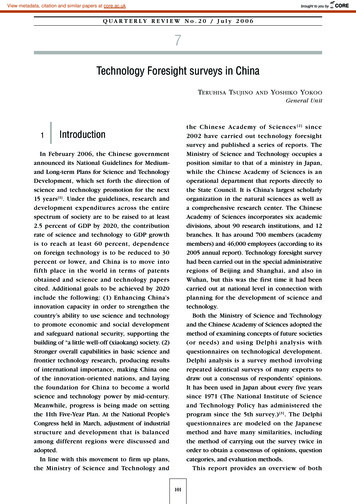

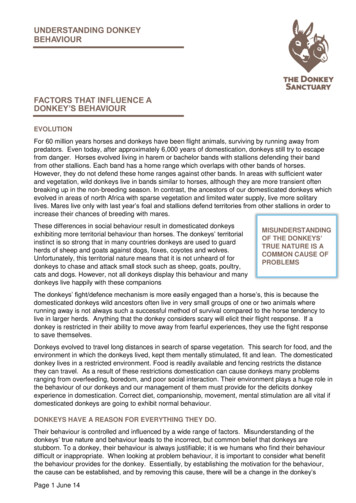
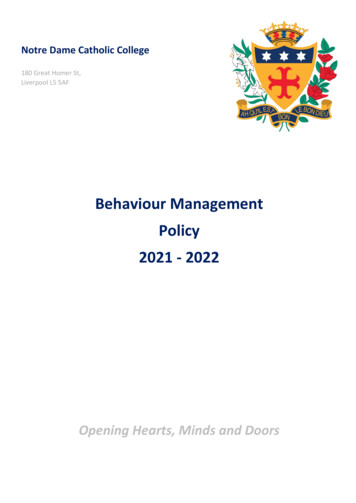
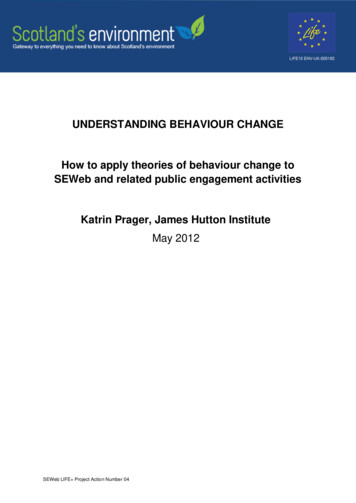

![Change Management Process For [Project Name] - West Virginia](/img/32/change-20management-20process-2003-2022-202012.jpg)